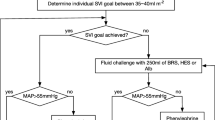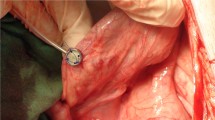Abstract
Background
The aim of this study was to investigate if colloid infusions have different effects on intestinal anastomotic healing when compared to crystalloid infusions depending on the amount of the administered volume.
Materials and methods
Twenty-eight Wistar rats were randomly assigned to four groups receiving different amounts of either a crystalloid (Cry) or a colloid (Col) infusion solution. Animals with volume restriction (Cry (−) or Col (−)) were treated with a low and animals with volume overcharge (Cry (+) or Col (+)) with a high flow rate. All animals received an infusion for a 60-min period, while an end-to-end small bowel anastomosis was performed. At reoperation, the anastomotic bursting pressure (millimeters of mercury) was measured, as well as anastomotic hydroxyproline concentration. The presence of bowel wall edema was assessed histologically.
Results
Median bursting pressures were comparable in the Col (−) [118 mm Hg (range 113–170)], the Cry (−) [118 mm Hg (78–139)], and the Col (+) [97 mm Hg (65–152)] group. A significantly lower median bursting pressure was found in animals with crystalloid volume overload Cry (+) [73 mm Hg (60–101)]. Corresponding results were found for hydroxyproline concentration. Histology revealed submucosal edema in Cry (+) animals.
Conclusions
In case of a fixed, high-volume load, colloids seem to have benefits on intestinal anastomotic healing when compared to crystalloid infusions.




Similar content being viewed by others
References
Brandstrup B, Tonnesen H, Beier-Holgersen R et al (2003) Effects of intravenous fluid restriction on postoperative complications: comparison of two perioperative fluid regimens: a randomized assessor-blinded multicenter trial. Ann Surg 238:641–648
Lobo DN, Bostock KA, Neal KR, Perkins AC, Rowlands BJ, Allison SP (2002) Effect of salt and water balance on recovery of gastrointestinal function after elective colonic resection: a randomised controlled trial. Lancet 359:1812–1818
Nisanevich V, Felsenstein I, Almogy G, Weissman C, Einav S, Matot I (2005) Effect of intraoperative fluid management on outcome after intraabdominal surgery. Anesthesiology 103:25–32
MacKay G, Fearon K, McConnachie A, Serpell MG, Molloy RG, O'Dwyer PJ (2006) Randomized clinical trial of the effect of postoperative intravenous fluid restriction on recovery after elective colorectal surgery. Br J Surg 93:1469–1474
Khoo CK, Vickery CJ, Forsyth N, Vinall NS, Eyre-Brook IA (2007) A prospective randomized controlled trial of multimodal perioperative management protocol in patients undergoing elective colorectal resection for cancer. Ann Surg 245:867–872
Mythen M, Vercueil A (2004) Fluid balance. Vox Sang 87(Suppl1):77–81
Prien T, Backhaus N, Pelster F, Pircher W, Bunte H, Lawin P (1990) Effect of intraoperative fluid administration and colloid osmotic pressure on the formation of intestinal edema during gastrointestinal surgery. J Clin Anesth 2:317–323
Lobo DN (2004) Fluid, electrolytes and nutrition: physiological and clinical aspects. Proc Nutr Soc 63:453–466
Lobo DN (2009) Fluid overload and surgical outcome: another piece in the jigsaw. Ann Surg 249:186–188
Marjanovic G, Villain C, Juettner E et al (2009) Impact of different crystalloid volume regimes on intestinal anastomotic stability. Ann Surg 249:181–185
Reddy GK, Enwemeka CS (1996) A simplified method for the analysis of hydroxyproline in biological tissues. Clin Biochem 29:225–229
Campbell IT, Baxter JN, Tweedie IE, Taylor GT, Keens SJ (1990) IV fluids during surgery. Br J Anaesth 65:726–729
Grocott MP, Mythen MG, Gan TJ (2005) Perioperative fluid management and clinical outcomes in adults. Anesth Analg 100:1093–1106
Chan ST, Kapadia CR, Johnson AW, Radcliffe AG, Dudley HA (1983) Extracellular fluid volume expansion and third space sequestration at the site of small bowel anastomoses. Br J Surg 70:36–39
Thornton FJ, Barbul A (1997) Healing in the gastrointestinal tract. Surg Clin North Am 77:549–573
Hoffmann JN, Vollmar B, Laschke MW, Inthorn D, Schildberg FW, Menger MD (2002) Hydroxyethyl starch (130 kD), but not crystalloid volume support, improves microcirculation during normotensive endotoxemia. Anesthesiology 97:460–470
Lang K, Boldt J, Suttner S, Haisch G (2001) Colloids versus crystalloids and tissue oxygen tension in patients undergoing major abdominal surgery. Anesth Analg 93:405–409 (3rd contents page)
Mythen MG, Webb AR (1995) Perioperative plasma volume expansion reduces the incidence of gut mucosal hypoperfusion during cardiac surgery. Arch Surg 130:423–429
Boldt J, Ducke M, Kumle B, Papsdorf M, Zurmeyer EL (2004) Influence of different volume replacement strategies on inflammation and endothelial activation in the elderly undergoing major abdominal surgery. Intensive Care Med 30:416–422
Lang K, Suttner S, Boldt J, Kumle B, Nagel D (2003) Volume replacement with HES 130/0.4 may reduce the inflammatory response in patients undergoing major abdominal surgery. Can J Anaesth 50:1009–1016
Moretti EW, Robertson KM, El-Moalem H, Gan TJ (2003) Intraoperative colloid administration reduces postoperative nausea and vomiting and improves postoperative outcomes compared with crystalloid administration. Anesth Analg 96:611–617 (table of contents)
Hiltebrand LB, Kimberger O, Arnberger M, Brandt S, Kurz A, Sigurdsson GH (2009) Crystalloids versus colloids for goal-directed fluid therapy in major surgery. Crit Care 13:R40
Holte K, Jensen P, Kehlet H (2003) Physiologic effects of intravenous fluid administration in healthy volunteers. Anesth Analg 96:1504–1509 (table of contents)
Jacob M, Chappell D, Rehm M (2007) Clinical update: perioperative fluid management. Lancet 369:1984–1986
Author information
Authors and Affiliations
Corresponding author
Additional information
Goran Marjanovic and Christian Villain have equally contributed to the manuscript and share primary authorship.
Rights and permissions
About this article
Cite this article
Marjanovic, G., Villain, C., Timme, S. et al. Colloid vs. crystalloid infusions in gastrointestinal surgery and their different impact on the healing of intestinal anastomoses. Int J Colorectal Dis 25, 491–498 (2010). https://doi.org/10.1007/s00384-009-0854-4
Accepted:
Published:
Issue Date:
DOI: https://doi.org/10.1007/s00384-009-0854-4




